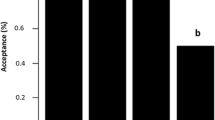Summary
Differential predation pressure and the probability of predation on a Batesian mimicry complex and on alternative prey were estimatedin a field experiment. The mimicry complex was composed of a noxious model (Eleodes obscura (Say)) and a palatable mimic (Stenomorpha marginata (LeConte)). House crickets (Acheta domesticus) (Linn.) were used as alternative prey. The experiment was conducted for 23 nights in August and September to approximate the peak seasonal activity time period during which both models and mimics normally are exposed to predation while foraging and depositing eggs. Each night thirty prey in ratios of 16 models: 7 mimics: 7 crickets were exposed for 2.5 h to a suite of predators consisting of pallid bats (Antrozous pallidus), striped skunks (Mephitis mephitis) and ringtails (Bassariscus astutus) that had free access to the prey. The model-mimic ratio was similar to that found in nature. Predators obtained prey on 11 of the 23 nights and preferred the alternative prey (crickets) in proportions higher than was expected from a predation rate that was equal on all species of prey. Mimics were taken by predators at a rate proportional to their abundance, while models were taken at a rate considerably lower than their relative abundance. This suggests that at least some of the predators could distinguish between models and mimics and were willing to eat the mimics at higher frequencies than they were willing to eat the models. However, although the mimicry is not perfect with respect to the entire predator suite, the mimics still gain an advantage by resembling the models, compared to the predation levels on the alternate prey.
Access this article
We’re sorry, something doesn't seem to be working properly.
Please try refreshing the page. If that doesn't work, please contact support so we can address the problem.
Similar content being viewed by others
References
Arnold SJ (1978) The evolution of a special class of modifiable behaviors in relation to environmental patterns. Am Nat 112:415–427
Brower JVZ (1958) Experimental studies of mimicry in some North American butterflies. I. Danaus plexippus and Limenitis archippus. Evolution 12:32–47
Brower LP, Brower JVZ, Westcott PW (1960) Experimental studies of mimicry: The reactions of toads (Bufo terrestris) to bumblebees (Bombus americanorum) and their robber fly mimics (Mallophora bomboides) with a discussion of aggressive mimicry. Am Nat 94:343–355
Brower LP, Brower JVZ, Stiles FG, Croze HJ, Hower AS (1964) Mimicry: Differential advantage of color patterns in the natural environment. Science 144:183–185
Brower LP, Cook LM, Croze HJ (1967) Predator responses to artificial Batesian mimics released in a neotropical environment. Evolution 21:11–23
Cook LM, Brower LP, Alcock J (1969) An attempt to verify mimetic advantage in a neotropical environment. Evolution 23:339–345
Dill LM (1975) Calculated risk taking by predators as a factor in Batesian mimicry. Canad J Zool 53:1614–1621
Doyen JT (1975) Differential predation of darkling ground beetles by Channel Island fox (Coleoptera: Tenebrionidae). Pan-Pacific Entomol 50:86–87
Eisner T, Meinwald J (1966) Defensive secretions of arthropods. Science 153:1341–1350
Estabrook GE, Jesperson DC (1974) Strategy for a predator encountering a model-mimic system. Am Nat 108:443–457
Ford EB (1963) Mimicry. Proc XVI Int Cong Zool Wash 4:184–186
Getty T (1985) Discriminability and the sigmoid functional response: How optimal foragers could stabilize model-mimic complexes. Am Nat 125:239–256
Holling CS (1965) The functional responses of predators to prey density and its role in mimicry and population regulation. Mem Entomol Soc Canada 45:1–60
Huheey JE (1980) The question of synchrony or “temporal sympatry” in mimicry. Evolution 34:614–616
Kramm RA, Kramm KR (1972) Activities of certain species of Eleodes in relation to season, temperature, and time of day at Joshua Tree National Monument (Coleoptera: Tenebrionidae). Southwest Nat 16:341–355
Murie OJ (1974) A field guide to animal tracks. Houghton Mifflin Co Boston
Nonacs P (1985) Foraging in a dynamic mimicry complex. Am Nat 126:165–180
O'Shea TJ, Vaughan TA (1977) Nocturnal and seasonal activities of the pallid bat, Antrozoas pallidus. J Mammal 58:269–284
Pallister JC (1954) The tenebrionid beetles of north central Mexico collected on the David Rockefeller Mexican Expedition of 1947 (Coleoptera: Tenebrionidae). Am Mus Novitates No 1697
Pasteur G (1982) A classificatory review of mimicry systems. Annu Rev Ecol Syst 13:169–199
Rettenmeyer CW (1970) Insect mimicry. Annu Rev Entomol 15:43–74
Rickard WH, Haverfield LE (1965) A pitfall trapping survey of darkling beetles in desert steppe vegetation. Ecology 46:873–875
Sheldon JK, Rogers LE (1984) Seasonal and habitat distribution of tenebrionid beetles in shrub-steppe communities of the Hanford Site in eastern Washington. Environ Entomol 13:214–220
Slobodchikoff CN (1978) Experimental studies of tenebrionid beetle predation by skunks. Behaviour 66:313–322
Slobodchikoff CN (1979) Utilization of harvester ant debris by tenebrionid beetles. Environ Entomol 8:770–772
Slobodchikoff CN (1983) Water balance and temperature preferences and their role in regulatory activity of tenebrionid beetles. Oikos 40:113–119
Slobodchikoff CN (1987) Aversive conditioning in a model-mimic system. Anim Behav 35:75–80
Slobodchikoff CN, Pedersen D (1975) Temperature preferences of two species of Eleodes (Tenebrionidae). Pan-Pacific Entomol 51:327–328
Sternberg JG, Waldbauer GP, Jeffords MR (1977) Batesian mimicry: selective advantage of color pattern. Science 195:681–683
Tanner VM, Packham WA (1965) Tenebrionid beetles of the Nevada test site. Brigham Young Univ Sci Bull, Biol Ser 6:1–44
Trapp GR (1978) Comparative behavioral ecology of the ringtail and gray fox in southwestern Utah. Carnivore 1:3–32
Tschinkel WR (1975) A comparative study of the chemical defense system of tenebrionid beetles: Chemistry of the secretions. Insect Physiol 21:753–783
Waldbauer GP, Sheldon JK (1971) Phenological relationship of some aculeate Hymenoptera, their dipteran mimics, and insectivorous birds. Evolution 25:371–382
Waldbauer GP, Sternberg JG, Maier CT (1977) Phenological relationships of wasps, bumblelees, their mimics, and insectivorous birds in an Illinois sand area. Ecology 58:583–592
Wise DH (1981) Seasonal and yearly patterns in the densities of darkling beetles (Coleptera: Tenebrionidae) in a montane community. Environ Entomol 10:350–358
Author information
Authors and Affiliations
Rights and permissions
About this article
Cite this article
Hetz, M., Slobodchikoff, C.N. Predation pressure on an imperfect Batesian micicry complex in the presence of alternative prey. Oecologia 76, 570–573 (1988). https://doi.org/10.1007/BF00397872
Received:
Issue Date:
DOI: https://doi.org/10.1007/BF00397872




